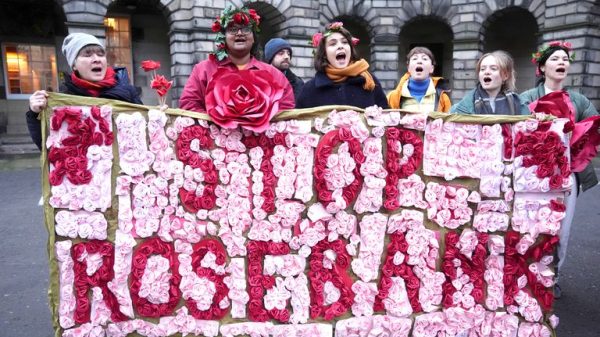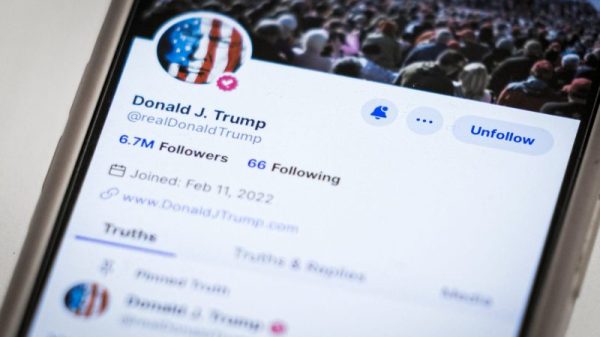People across the United States will be looking to the sky on Monday to witness a total solar eclipse. Others will be listening to it.
And to Harvard University astronomers working to transform the rare sight into sound, the eclipse should create a symphony.
“We mapped the bright light of the sun to a flute sound,” said Allyson Bieryla, an astronomer at Harvard. “Then it goes to a midrange, which is a clarinet, and then during totality, it kind of goes down to a low clicking sound, and that clicking even slows down during totality.”
Mark your calendars: eclipse
The scientists designed a boxy device — a bit larger than a cell phone — that converts light into audible tones in a process called sonification. The sounds change based on the intensity of the light, allowing people with blindness or low vision to follow the progress of the eclipse.
The device is called a LightSound, and hundreds of them will be at eclipse-viewing events on Monday.
“That image of totality is breathtaking and so it is visual, but that doesn’t mean that’s the only way you can interpret things or experience them,” said Bieryla, who runs the LightSound Project. “And for someone without sight, they need a different sense to experience it.”
Converting light into sound
The idea for LightSound was born during the last total eclipse in the United States in 2017. Bieryla started the project with astronomer Wanda Díaz-Merced, who experiences blindness and relies on similar technology to do her research. They created three prototypes — one in Jackson Hole, Wyoming, and two in Kentucky.
The current version of LightSound is the result of some tweaks and fine-tuning since those prototypes, but sonification has always been at the heart of it. The device uses a light sensor to take in data — in the case of an eclipse the data is light intensity, Bieryla said. Those numbers, the light intensity values, are then assigned an instrument sound using a MIDI synthesizer board in the device, she said. This allows the tones to change as the moon blocks the sun and Earth gets dark, so people with blindness can interact with the eclipse in ways they couldn’t previously.
Fast-forward to 2024, and the project has grown. Changes after the 2019 and 2020 total solar eclipses in South America, such as primarily using a printed circuit board instead of wires, made the device easier to build. With the help of local communities, the project was quickly able to scale up production, Bieryla said. The LightSound team hosts workshops in which anyone can learn to assemble a device.
“Instead of producing 20 in a day, we were producing 200 in a day, so it was a huge, huge improvement,” Bieryla said, emphasizing that the community element is “what made this project successful.”
She said they built and distributed about 900 devices for the 2024 eclipse, which went to sites in Mexico, the United States and Canada.
Of those hundreds scattered across the United States, 29 devices were sent to Ohio state parks and wildlife areas that are in the path of totality. The Ohio Department of Natural Resources partnered with Opportunities for Ohioans with Disabilities, or OOD, to provide LightSound to dozens of eclipse-watch parties.
Bernadetta King, program manager at the OOD’s Bureau of Services for the Visually Impaired, said people are excited to be fully included at eclipse events — not in a separate place but immersed with everyone else as event organizers will plug the device into speakers.
“Sometimes when you make something better for people with disabilities, you inadvertently make it better for everybody, so why don’t we just think that way to begin with?” King said. “Even the people that would be viewing the eclipse through glasses are hearing about this and say, ‘Oh, this is cool.’”
King, who also experiences blindness, said she feels people with vision-related disabilities are not often top of mind. Devices such as the LightSound could also be an opportunity to keep pushing sonification technology in other ways, she said.
“This is kind of a foot in the door to open an area that has traditionally not been considered when you think about people who have blindness and vision impairment,” King said, mentioning previous applications of sonification in weather, space and other science fields.
Other inclusive eclipse efforts
If you are not near an eclipse event that has a LightSound, the American Council of the Blind is hosting a virtual stream of the sound of various devices along the path of totality.
The Eclipse Soundscapes app is another resource for those who are visually impaired. The project, part of NASA’s Citizen Science initiative, will collect multisensory observations and recordings from people around the country.
In the app, there is a tool that uses vibrations and audio tones to convey each stage of the eclipse in addition to narrated descriptions. The project said the tool is “designed for you to hear and feel astronomical phenomena.”
Additionally, NASA partnered with the National Park Service and Earth to Sky on activities, including a webinar series to prepare interpreters for the event. National parks involved in the partnership will have elements for “the blind and low vision, neurodivergent children, the physically impaired, and those with hearing impairments” at watch parties across the country, the space agency said.
As for Bieryla and her team, there’s always another eclipse somewhere. Once this one is over, they will ship LightSounds to the next location. Because her small team can’t build devices for the whole world, the next goal is to teach people across the globe how to hold workshops. She said she hopes initiatives such as LightSound inspire young scientists.
“I’m hoping that there is a blind child that maybe experiences this device and says, ‘I want to do astronomy,’” Bieryla said, “and we need to have those resources in place for that student to be successful.”
Don’t miss out on upcoming eclipse and space stories! Follow the Astronomy topic to see the latest stories in your personalized feed with your free account.



























